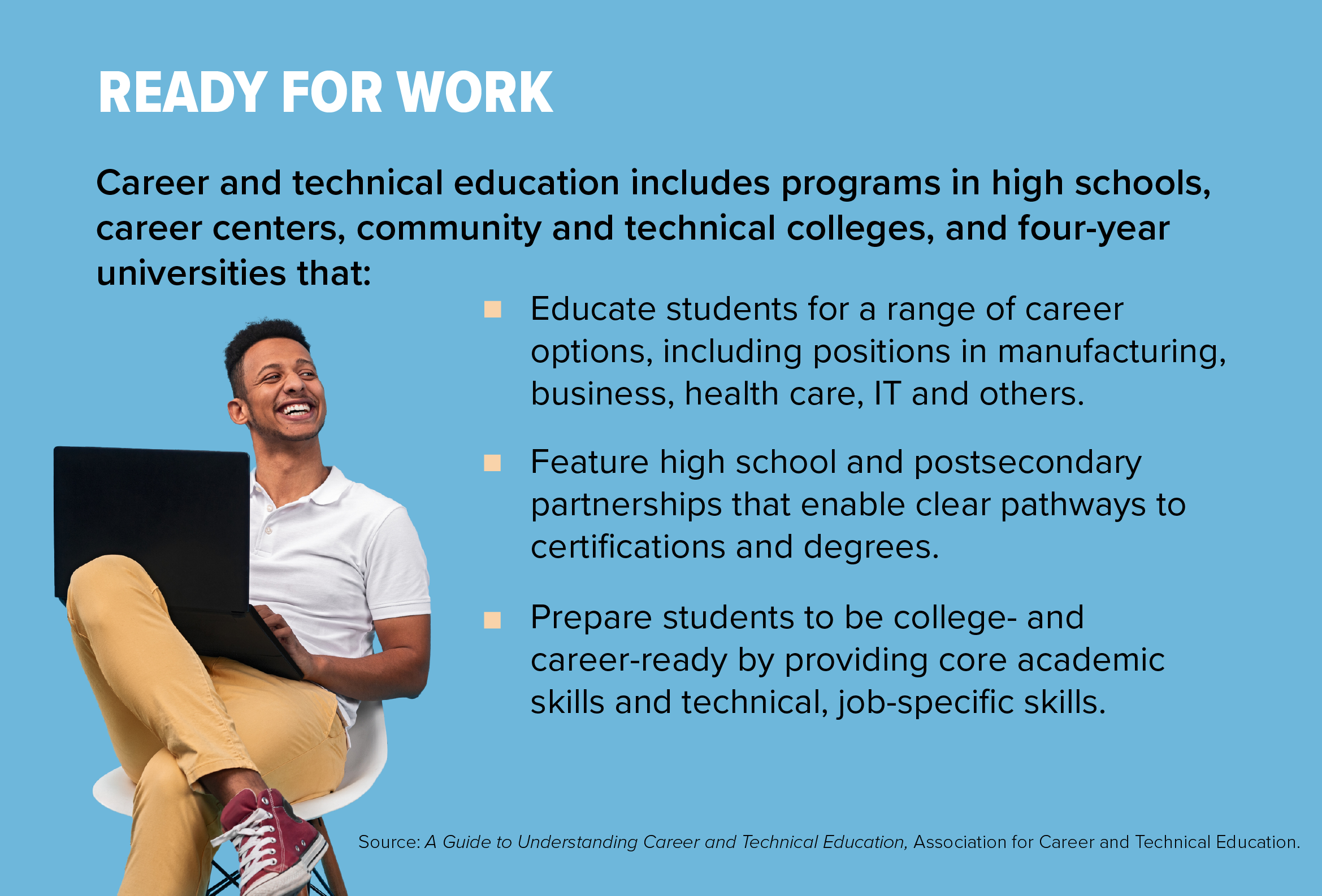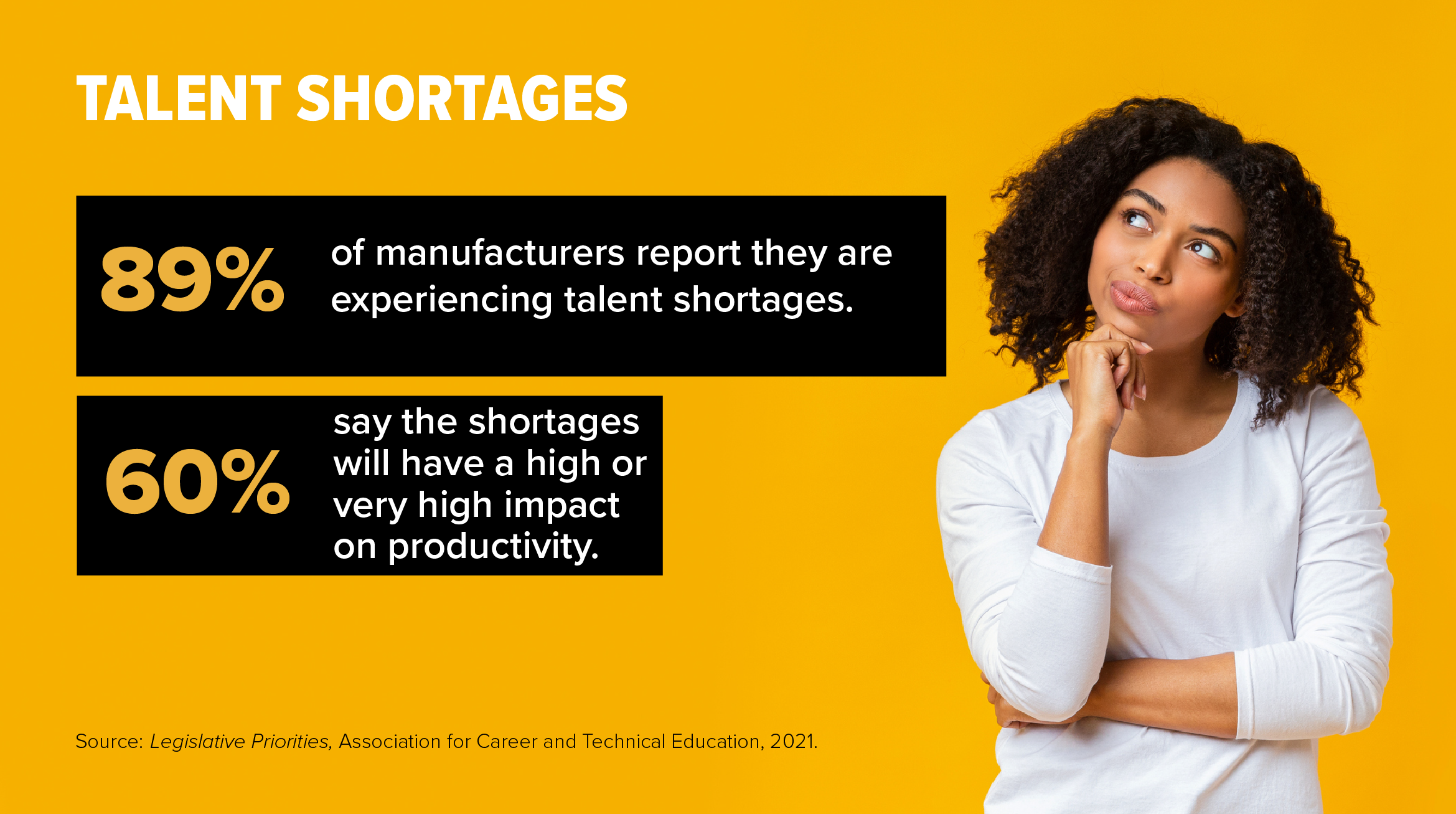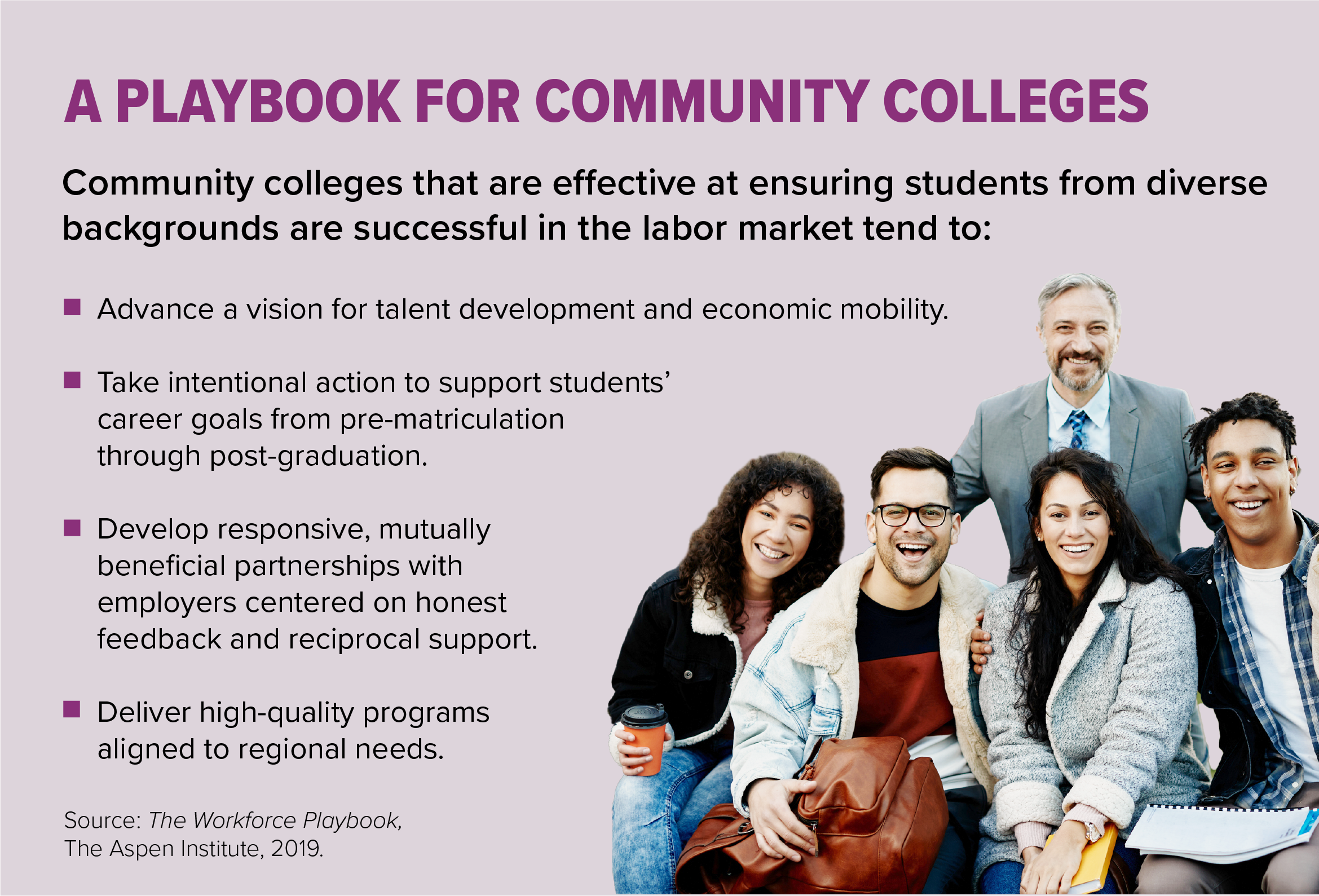Employers Partner with Community Colleges to Fill the Talent Pipeline
The more thought and rigor that employers, educators and students put into workforce development programs, the more beneficial these programs will be.
The U.S. economy has been slowed by the national talent gap, as companies in many sectors struggle to recruit and retain employees with the necessary skills for a range of positions.
For example, 89 percent of manufacturers report talent shortages, with 60 percent saying the shortages will have a high or very high impact on productivity, according to a report from the Association for Career and Technical Education (ACTE), an Alexandria, Va.-based national association for education professionals.
For many employers, part of the solution may lie in community and technical colleges that are often located just a short drive from their doorsteps.
Teaching Unusual Skills
DeAndre Lurry, 23, is a recent graduate of Elyria, Ohio-based Lorain County Community College's (LCCC) microelectronic manufacturing bachelor's degree program. Lurry enjoys his work on a manufacturing line creating printed circuit boards for welding equipment at Cleveland-based electronics manufacturer Lincoln Electric—and earning more than $75,000 per year.
Before graduating and starting full time with the company, Lurry worked for two years as a paid intern at Lincoln Electric three days a week. He earned a starting hourly wage of $14 that rose to nearly $17.50, which enabled him to graduate with an associate degree and then a bachelor's degree without student debt.
Without guidance from an LCCC professor regarding the microelectronic manufacturing specialty, Lurry says, he almost certainly would not have known that this lucrative profession existed.
Geoff Lipnevicius, Lurry's boss and senior manager of organizational effectiveness at Lincoln, says programs like the one Lurry completed at LCCC offer the company a valuable source of unusually skilled new labor.
"As the magnitude and complexity of the equipment we manufacture has increased, so has the entry-level talent gap," Lipnevicius says. Often, entry-level candidates lack technical training, computer knowledge or math skills, he explains. "LCCC is the first program in Ohio to offer a bachelor of applied science in microelectronic manufacturing. Virtually every machine that we manufacture has printed circuit boards, so this level of knowledge and the soldering skills that the students gain is a direct benefit to us. The students are sought after in many different areas within our manufacturing plant."
Workforce development programs between community colleges—which predominantly offer two-year associate degrees and shorter-term certificate and industry certification programs—and local employers often feature internships, apprenticeships and coursework that tie learning and student experiences to employer needs.
The more thought and rigor that employers, educators and students put into workforce development programs, the more beneficial these programs will be for all, says Joseph B. Fuller, professor of management practice at Harvard Business School and co-head of its Managing the Future of Work Project. He notes that short, unpaid internships often don't have the same impact as paid internships and apprenticeships that involve longer-term relationships and a chance for students to perform work comparable to that of full-time employees.

Shaping Workforce Programs
Workforce development programs are not new; some, such as the programs at Toyota Motor North America (TMNA), have evolved to prodigious sizes and levels of sophistication.
Toyota has utilized workforce programs internally or through external partners since around the time the Japanese company began major manufacturing operations in the U.S. in 1975, says Dennis Dio Parker, a consultant supporting TMNA regional talent development. The carmaker's efforts included robust work/study partnerships with community colleges. Per Toyota's mantra, it has since "Kaizened"—or continuously improved—those programs.
"Work/learn is the strongest model, and the best outcomes are achieved when the employer chooses all education activities, including courses at college, activities at college and activities at work," Parker says.
One of Toyota's workforce development programs, the FAME Career Pathway, prepares technicians to maintain factory equipment. The core effort in the FAME pathway is the Advanced Manufacturing Technician program. It's a two-year intensive work/learn experience, with students attending classes two days each week and working in a manufacturing facility three days a week, for five straight semesters.
Toyota developed its own community college training programs to get the results it wanted, Parker says. "To be at a global-best level, we found that community college programs, as they existed, were not a fit and were not producing the type of graduate that we needed to be No. 1 globally," Parker says. "So now, to be accepted into the FAME program, community colleges must agree to the changes we recommend, and we make a tremendous effort to support them and make it work."
Because of its success and the demand for manufacturing technicians, the FAME program has spread beyond Toyota. In 2019, the company struck a deal with The Manufacturing Institute (the nonprofit education and workforce development partner of the National Association of Manufacturers) to transition stewardship of FAME to the nonprofit group so that it could be scaled nationwide. The program has more than 350 participating employers in 14 states at 38 colleges and universities, Parker says.
Parker notes that the FAME program has a graduation rate of more than 80 percent and that 85 percent of those individuals receive immediate placement with the original sponsoring employer. (Almost all of the remaining graduates either are immediately placed with a different employer or voluntarily proceed to a four-year university program.) In addition, 90 percent of students continue in the program after one year. "The ROI [return on investment] for employers is incredible," he says.
Meeting Critical Needs
In 2016, anticipating a wave of retirements and wanting to diversify its talent pipeline, Schaumburg, Ill.-based insurance provider Zurich North America launched an apprenticeship program with nearby Harper College in Palatine. This program became the first insurance apprenticeship to be certified by the U.S. Department of Labor, according to Jillian Walsh, director of Zurich's apprenticeship program.
The earn-while-you-learn program started with apprenticeships in general insurance, focused on claims and underwriting. Apprentices work at Zurich three days per week and focus on college coursework two days a week in pursuit of an associate of applied science degree in business.
Apprentices are considered full-time employees and receive full benefits, including paid time off and 401(k) matching funds. Leaders from throughout Zurich provide coaching and mentoring on networking, effective communications and other professional skills. Zurich pays for all tuition, fees and books. Individuals who complete the two-year program and continue working at Zurich are promoted one level.
Walsh says the program has been so successful that the company has expanded it to include apprenticeships in other areas of critical need, such as IT and cybersecurity, and to new regions where Zurich has operations.
The apprenticeship program averages 25 to 35 participants per year. So far, Zurich has hired 146 people through the program, with a cumulative retention rate of 85 percent from 2016 to the present, Walsh says.
"We've also learned that apprenticeships are very responsive and adaptable to evolving needs," she adds. "From our experience, we believe every function has 'apprenticeable' work."

Getting Plugged In
Work/study programs can help address perennial problems for employers—namely, employee turnover and hiring mismatches. These programs tend to yield successful employee outcomes because curricula are tailored to the direct and current workforce skills needs of employers, says Michael Connet, ACTE's associate deputy executive director of outreach and partner development.
Program participants benefit from the arrangements as well. One reason is because community colleges are economical. Students can attend public community and technical colleges for a fraction of the cost of tuition at four-year higher education institutions: Annual tuition rates for in-state community college students averaged $5,014 in 2020-2021 versus $15,507 for private college tuition, according to Community College Review. Community colleges are also good at providing learning in a variety of different formats, including distance learning and evening and weekend sessions that accommodate students working either part time or full time, Connet says.
In addition, community colleges disproportionately attract women, people of color, first-generation college students and students from lower-income groups. That's why it makes sense to integrate workforce development programs into organizations' efforts to address diversity, equity and inclusion, notes Becky Klein-Collins, vice president for impact at Indianapolis-based Council for Adult and Experiential Learning (CAEL), an organization that supports adult learners as they navigate education and employment.
It's important that employers know their own needs, as well as the range of offerings at local community colleges, when setting up partnerships, says Joshua Wyner, founder and executive director of the College Excellence Program at the Aspen Institute, a Washington, D.C.-based think tank.
The Aspen Institute guidebook Aligning Talent and Opportunity: An Employer Guide to Effective Community College Partnership is a proven resource for employers considering starting a workforce development program. The publication examines the processes for developing and strengthening employer/community partnerships and provides useful questions for employers to ask potential community college partners.
"Oftentimes, for example, employers do not know the full span of credentials that a college can offer," Wyner says.
ACTE has designed a rigorous framework of what constitutes a quality career and technical education (CTE) program, as measured by 12 elements and 92 criteria. The organization also provides examples on its website of workforce development collaborations between employers and community colleges.

Finding Good Partners
Among the top-ranked community college CTE providers nationally is Racine, Wis.-based Gateway Technical College. Gateway has workforce training programs for 230 community employers. It has 20,000 students in such programs at any given time and boasts a 96 percent placement rate for associate degree graduates, according to Gateway President Bryan Albrecht. He cites these components as being key to Gateway's success:
- A pathway program involving K-12 students. The program introduces them to technical concepts and coursework and makes them aware of Gateway's and local employers' work/study programs and careers.
- A strong focus on partnerships with local employers. This ensures there are jobs at the end of the training.
- A variety of learning options. Gateway offers stackable credentials and industry certifications in more than 200 six-month-or-less industry credentialing and certificate programs and one-year diploma programs. Completion of these programs counts toward associate degrees, giving employees incentive to continue their education and workforce development.
- A focus on diversity. Gateway makes an extra effort to recruit and address the needs of first-generation college students, English-language learners and adult learners who need basic education or who already have a bachelor's or master's degree and are seeking additional education based on the needs of their industry.
Employers establishing workforce development programs should explore a variety of external resources. For example, many state and local consortia of employers have created apprenticeship networks that can amortize organizational, administrative and marketing costs and time demands. These networks also can provide a sufficient number of employees to support particular community college programs.
Additionally, some national, regional and state industry and trade groups have established their own workforce development programs to provide similar support. The Energy Providers Coalition for Education, for example, is an alliance of utility industry employers administered by CAEL that collaborates with accredited education providers to develop online solutions to specific education and training needs, says Jack Mills, senior vice president for partnership, insights and impact at CAEL.
The ACTE has 94 trade organizations as part of its coalition, according to Connet, who notes that all of them "are doing wonderful things in building out workforce development and CTE campaigns."
Furthermore, many federal, state and local programs offer support to community colleges, employers and students to defray the costs of workforce development program creation and participation. And usually, community colleges have workforce teams made up of experts who can identify such sources, says Cindy Kushner, director of school and community partnerships at LCCC.
So, for employers that just can't find workers with the necessary skills, chances are there's a community college nearby that could help develop their workforce and help fill their talent needs.
David Tobenkin is a freelance writer based in the greater Washington, D.C., area and a higher education media fellow at the Institute for Citizens & Scholars.
Explore Further
SHRM provide resources to help business leaders close the skills gap through career and technical education
The Reskilling Imperative
At a time when many employers worry about keeping up with their talent needs, HR professionals are playing a heightened role to stave off a talent crisis.
Retraining Is a Key Employment Strategy at Kaiser PermanenteA Q&A with Monica Morris, senior director for national workforce planning and development at Kaiser Permanente, about how the company is meeting unprecedented staffing and training challenges.
Companies Turn to Apprentices to Fill White-Collar Jobs
Apprenticeships typically are considered the training ground for blue-collar industries such as manufacturing and construction, but an increasing number of students are entering white-collar apprenticeships.
SHRM Resource Hub Page: Skills Gap and Workforce Readiness
Resources to help employers address the growing skills gap through training, development and use of nontraditional workers.
SHRM Toolkit: Using Government and Other Resources for Employment Training Programs
This toolkit discusses the various options for organizations that want to implement employment and training programs supported by federal, state and local governments.
U.S. Department of Labor Toolkit: Building Registered Apprenticeship Programs
This toolkit provides helpful steps and resources to start and register an apprenticeship program, from exploring the apprenticeship model as a workforce strategy to launching a new program.



